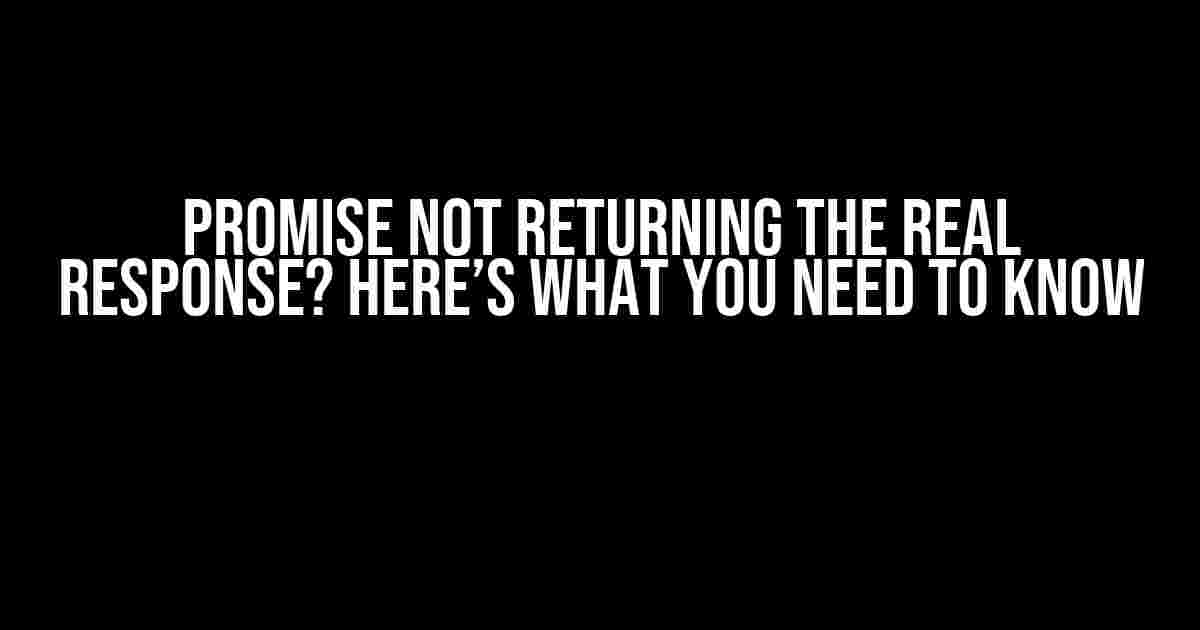Are you tired of dealing with promises that don’t return the real response? You’re not alone! Many developers struggle with this issue, and it’s frustrating, to say the least. But don’t worry, we’ve got you covered. In this article, we’ll dive into the world of promises and explore the reasons why they might not be returning the real response. Buckle up, folks!
Understanding Promises
Before we dive into the issue at hand, let’s take a step back and understand what promises are. In JavaScript, a promise is an object that represents the eventual completion (or failure) of an asynchronous operation. A promise can be in one of three states:
- Pending: Initial state, where the operation has not started yet.
- Fulfilled: The operation has completed successfully.
- Rejected: The operation has failed.
When a promise is fulfilled, it returns a value, known as the resolution. On the other hand, when a promise is rejected, it returns an error, known as the rejection.
The Problem: Promise not Returning the Real Response
So, what happens when a promise doesn’t return the real response? Well, there are several reasons why this might occur. Let’s explore some of the most common culprits:
Reason 1: Inadequate Error Handling
Error handling is crucial when dealing with promises. If you’re not catching errors properly, you might end up with a promise that doesn’t return the real response. Here’s an example:
fetch('https://example.com/api/data')
.then(response => response.json())
.then(data => console.log(data))
.catch(error => console.error('Error:', error));In the above example, if the API request fails, the promise will be rejected, and the error will be caught by the catch block. However, if you’re not logging the error properly, you might not even realize that the promise has been rejected.
Reason 2: Incorrect Promise Chaining
Promise chaining is a common technique used to handle asynchronous operations. However, if you’re not chaining promises correctly, you might end up with a promise that doesn’t return the real response. Here’s an example:
fetch('https://example.com/api/data')
.then(response => {
response.json();
console.log('Do something else');
})
.then(data => console.log(data));In the above example, the promise is not returning the real response because the then block is not returning a value. The console.log statement is executed, but the promise is not chained correctly.
Reason 3: Missing or Incorrect Async/Await
Async/await is a syntax sugar on top of promises that makes asynchronous code look synchronous. However, if you’re not using async/await correctly, you might end up with a promise that doesn’t return the real response. Here’s an example:
async function fetchData() {
const response = await fetch('https://example.com/api/data');
console.log(response.json()); // This will not work
}
fetchData();In the above example, the async function fetchData is not returning a promise. The console.log statement will execute immediately, without waiting for the promise to resolve.
Solutions to the Problem
Now that we’ve explored the reasons why promises might not return the real response, let’s dive into the solutions:
Solution 1: Improve Error Handling
One of the most effective ways to solve this problem is to improve error handling. Here’s an example:
fetch('https://example.com/api/data')
.then(response => response.json())
.then(data => console.log(data))
.catch(error => {
console.error('Error:', error);
throw error; // Rethrow the error to propagate it
});By rethrowing the error, we ensure that the promise is rejected, and the error is propagated to the next catch block.
Solution 2: Use Promise Chaining Correctly
To solve this problem, you need to make sure that each then block returns a value. Here’s an example:
fetch('https://example.com/api/data')
.then(response => response.json())
.then(data => {
console.log('Do something else');
return data; // Return the data
})
.then(data => console.log(data));By returning the data from each then block, we ensure that the promise is chained correctly, and the real response is returned.
Solution 3: Use Async/Await Correctly
To solve this problem, you need to make sure that you’re using async/await correctly. Here’s an example:
async function fetchData() {
try {
const response = await fetch('https://example.com/api/data');
const data = await response.json();
console.log(data); // This will work
} catch (error) {
console.error('Error:', error);
}
}
fetchData();By using try-catch blocks and awaiting the promise resolution, we ensure that the real response is returned.
Best Practices for Working with Promises
To avoid the problem of promises not returning the real response, follow these best practices:
- Always handle errors properly using catch blocks.
- Make sure each then block returns a value.
- Use async/await correctly, with try-catch blocks.
- Avoid using callbacks with promises.
- Test your code thoroughly to ensure that promises are returning the real response.
Conclusion
Promises can be tricky to work with, but with the right techniques and best practices, you can ensure that they return the real response. Remember to handle errors properly, chain promises correctly, and use async/await correctly. By following these tips and solutions, you’ll be well on your way to becoming a master of promises.
| Reason | Solution |
|---|---|
| Inadequate Error Handling | Improve Error Handling |
| Incorrect Promise Chaining | Use Promise Chaining Correctly |
| Missing or Incorrect Async/Await | Use Async/Await Correctly |
By following the solutions and best practices outlined in this article, you’ll be able to troubleshoot and fix promises that don’t return the real response. Happy coding!
Frequently Asked Question
Having trouble with promises not returning the real response? You’re not alone! Here are some frequently asked questions to help you navigate this common conundrum.
Why does my promise not return the real response immediately?
Ah, patience young grasshopper! Promises are asynchronous, which means they don’t block the execution of code. Instead, they return immediately with a pending status, allowing other code to run in the meantime. The real response will come later, when the promise is resolved or rejected.
How can I get the real response from a promise?
Easy peasy! You can use `.then()` to handle the resolved value, like so: `promise.then(response => console.log(response))`. Alternatively, you can use `async/await` to make your code look synchronous, like this: `const response = await promise; console.log(response)`.
What happens if I don’t return anything from a promise?
Oh dear, you might end up with an unresolved promise! If you don’t return anything, the promise will remain pending indefinitely, leaving you hanging. Make sure to return a value, throw an error, or resolve/reject the promise to avoid this situation.
Can I cancel a promise?
Unfortunately, no! Promises, by design, cannot be cancelled once they’re created. You can, however, use techniques like timeouts or cancellation tokens to achieve similar results.
Are there any best practices for working with promises?
Absolutely! Always handle errors with `.catch()`, use `async/await` for readability, and wrap promise chains in a `try-catch` block to avoid uncaught errors. Lastly, keep your promise chains short and sweet to avoid the infamous “callback hell”.


